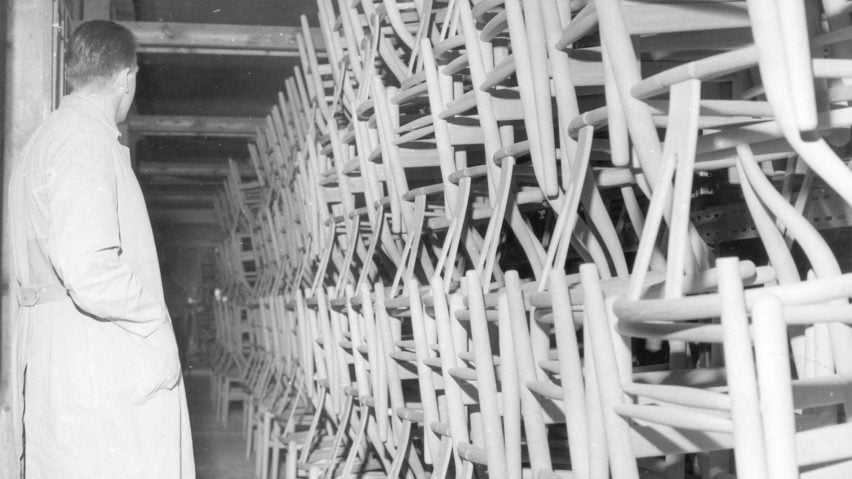Continuing our mid-century modern series, we spotlight the CH24 Wishbone Chair, which was created by Danish designer Hans J Wegner for furniture manufacturer Carl Hansen & Son in 1949.
The iconic chair, with its characteristic Y-shaped back support, has been in production at Carl Hansen & Son since its launch in 1950.
Though Wegner designed over 500 chairs, the CH24 Wishbone Chair is the most well-known.
The CH24 Wishbone Chair has a combined back and armrest with a curving steam-bent wooden top that is connected to the seat by a central Y-shaped support.
Its production involves over 100 different steps, including creating a hand-woven seat made from around 120 meters of paper cord.
Carl Hansen & Son CEO Knud Erik Hansen explained that the chair came into production as Denmark was gaining international recognition as a design powerhouse.
"The Wishbone Chair was put into production in 1950 at a time when Danish design was very progressive and was laying the foundation for Denmark as a design nation," he told Dezeen.
"Some of the designers at that time, for example Kaare Klint and Børge Mogensen, had a very functionalistic and almost mathematical approach to design in order to design furniture that was created for the human body and fitted into people's lives."
"Some of the other designers, such as Ole Wanscher and Finn Juhl, had a more sculptural approach and created soft and almost artistic designs, not based on function primarily," Hansen continued.
According to Hansen, Wegner's approach to design was different to his contemporaries, as he married the functionality of his chairs with sculptural qualities.
By doing this, Hansen believes Wegner embodied quintessential modern Danish design in the C24 Wishbone Chair.
"Wegner's approach was in the middle of these two schools and he created the Wishbone Chair as a functional chair but with a soft, distinct expression that is very aesthetically pleasing," Hansen said.
"In this way, he really captured the essence of modern Danish design in one chair."
Born in 1914 in the Danish town of Tønder, Wegner was one of the key contributors to mid-century modern Danish design and is particularly known for his chairs.
He worked as an apprentice to Danish master cabinetmaker H F Stahlberg before attending the School of Arts and Crafts in Copenhagen from 1936 to 1938.
Wegner was approached by architects Arne Jacobsen and Erik Møller in 1938 to create the furniture for Aarhus City Hall, which was completed in 1942. During this time, he also began collaborating with cabinetmaker Johannes Hansen.
In 1943, Wegner founded his own design studio and designed his China Chair, which was informed by 17th and 18th-century Chinese design and is still in production today.
He went on to design over 500 chairs, of which more than 100 went into mass production, before passing away aged 92.
The CH24 Wishbone Chair was an original commission for Carl Hansen & Son, which wanted a high-quality chair that could be mass-produced for a wider market.
Wegner designed three other chairs for the commission – CH22, CH23 and CH25. While all went into production, CH24 gained the greatest commercial success.
Hansen credits its long-lasting popularity to its simple yet impactful shape, which was characteristic of Wegner's design style.
"Aesthetically, the Wishbone Chair has a lasting appeal with its soft lines and very strong, almost graphical, silhouette," Hansen said.
"Hans J Wegner focused on pairing his designs down to the bare minimum and this is very much the case with the Wishbone Chair – the materials strike the perfect balance in order to be elegant and yet stable and durable."
"Wegner always prioritised quality, but he was also forward-thinking and was among the first to incorporate serial production in his designs, thereby making them more democratic," he continued.
"All of these values are how we today define Danish design and the legacy that we continuously build upon."
The photography is courtesy of Carl Hansen & Son.
Mid-century modern
This article is part of Dezeen's mid-century modern design series, which looks at the enduring presence of mid-century modern design, profiles its most iconic architects and designers, and explores how the style is developing in the 21st century.
This series was created in partnership with Made – a UK furniture retailer that aims to bring aspirational design at affordable prices, with a goal to make every home as original as the people inside it. Elevate the everyday with collections that are made to last, available to shop now at made.com.

